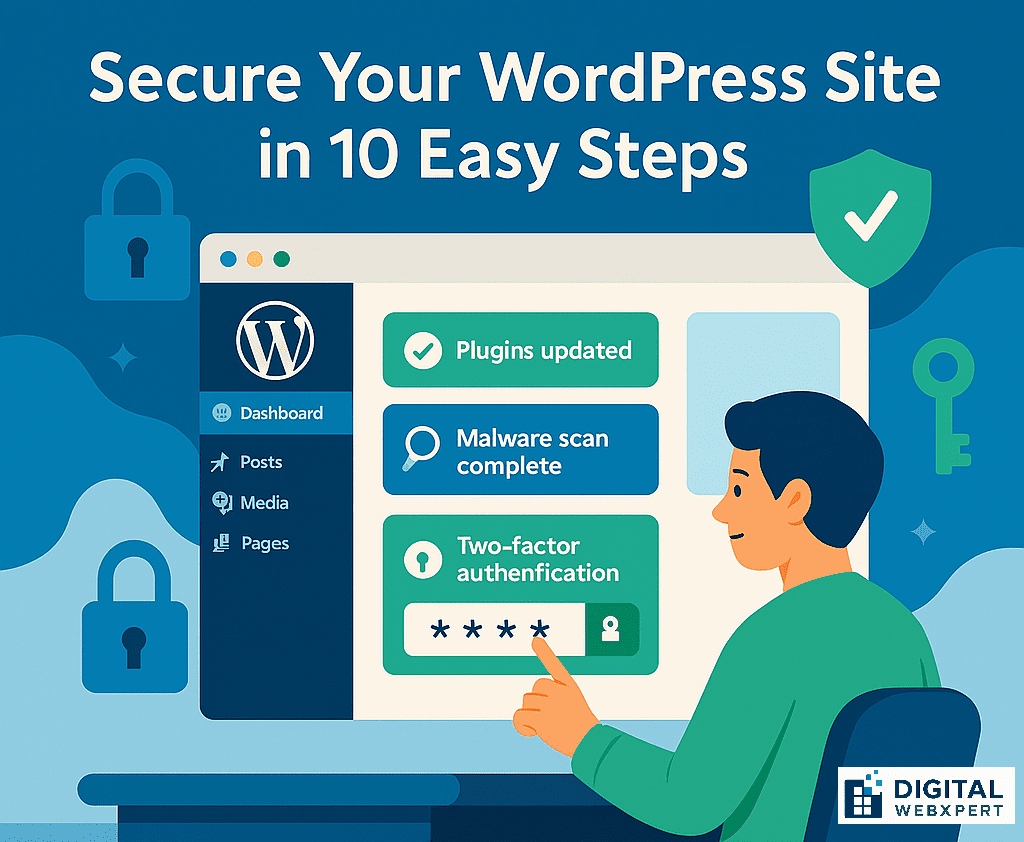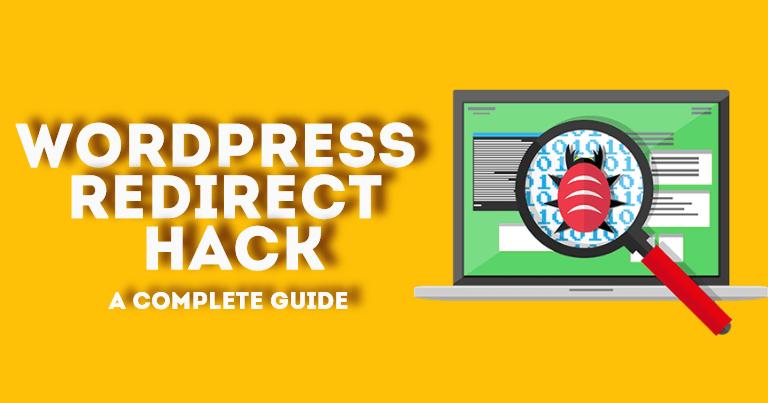Blog Title
Secure Your WordPress Site in 10 Easy Steps
SEO Title
Secure Your WordPress Site in 10 Easy Steps – Ultimate 2025 Guide
SEO Meta Description
Secure your WordPress site in 10 easy steps with this 2025 guide. Learn proven techniques—strong passwords, two-factor authentication, SSL, backups, hardening, and more.
Focus Keyword
Secure Your WordPress Site
URL Slug
secure-your-wordpress-site-10-steps
Feature Image Prompt
A modern, flat-style illustration of a WordPress dashboard with security icons (padlock, shield, key) around it. Show a developer enabling two-factor authentication, updating plugins, and running a malware scan. Use a tech-friendly palette of blue, white, and green. Overlay the title: “Secure Your WordPress Site in 10 Easy Steps” and include space for Digital WebXpert branding.
Comma-Separated Tags
secure wordpress site, wordpress security steps, harden wordpress, wp security 2025, two-factor authentication, wp backups, ssl wordpress, security plugins, digital webxpert
Image Alt Title
Secure Your WordPress Site in 10 Easy Steps infographic
Secure Your WordPress Site in 10 Easy Steps
If you’re running a business or blog, it’s essential to secure your WordPress site. WordPress may be the most popular CMS in the world, but that also makes it one of the biggest targets for cyberattacks. Hackers exploit outdated themes, plugins, and weak login credentials every day.
In this guide, we’ll show you how to secure your WordPress site in 10 easy steps — from using strong passwords and two-factor authentication to advanced techniques like disabling XML-RPC and implementing firewalls. Whether you’re new or experienced, these best practices will help you stay ahead of modern threats.
1. Keep WordPress Core, Themes & Plugins Updated
To secure your WordPress site, updating everything is step one. WordPress regularly releases security updates:
- Enable automatic updates for minor core releases.
- Check for theme and plugin updates weekly.
- Remove inactive or abandoned plugins/themes.
Pro Tip: Use a staging environment to test updates before deploying to production.
2. Use Strong Passwords & Change Default “admin” Username
Weak credentials are a top vulnerability. To secure your WordPress site, enforce:
- Strong, unique passwords (at least 12 characters, mixed cases, symbols).
- No “password123” or “admin” user. Rename or delete the default admin account.
- Use a password manager (LastPass, 1Password) to generate and store credentials.
3. Enable Two-Factor Authentication (2FA)
Adding a second verification step significantly helps secure your WordPress site:
- Install a 2FA plugin (e.g., Google Authenticator, Wordfence 2FA).
- Require 2FA for all administrator and editor accounts.
- Offer backup codes in case users lose their device.
4. Install a Trusted Security Plugin
A comprehensive plugin can automate many efforts to secure your WordPress site:
- Wordfence, Sucuri Security, or iThemes Security.
- Features include firewall, malware scanning, login lockdown, and alerts.
- Configure notifications for file changes, login failures, and suspicious activity.
5. Use SSL/TLS & Force HTTPS
To secure your WordPress site, encrypt all data in transit:
- Obtain an SSL certificate (free via Let’s Encrypt or paid through hosting).
- In Settings → General, update both URLs to “https://”.
- Use a plugin (Really Simple SSL) or server rules to enforce HTTPS.
6. Regular Backups & Offsite Storage
Backups are your insurance. To secure your WordPress site:
- Schedule daily or real-time backups of files and database.
- Store backups offsite: Amazon S3, Google Drive, or Dropbox.
- Test restores quarterly to ensure backup integrity.
7. Limit Login Attempts & Change Login URL
To further secure your WordPress site:
- Use Limit Login Attempts Reloaded or Wordfence to block brute-force attempts.
- Rename
/wp-login.phpto something unique. - Enable CAPTCHA to prevent bots.
8. Harden File Permissions & Disable File Editing
Permissions matter. Here’s how to secure your WordPress site on the file level:
- Set directories to 755 and files to 644.
- In
wp-config.php, add:
define('DISALLOW_FILE_EDIT', true);
define('DISALLOW_FILE_MODS', true);
- Disable PHP in uploads directory using .htaccess or nginx rules.
9. Disable XML-RPC & Unused Features
To secure your WordPress site, turn off unnecessary features:
- Disable XML-RPC using plugins or .htaccess rules.
- Turn off pingbacks and trackbacks.
- Remove unused themes and plugins.
10. Regular Security Audits & Monitoring
Constant vigilance is key to secure your WordPress site:
- Run audits quarterly.
- Use WPScan, Sucuri SiteCheck, or security plugin dashboards.
- Review user sessions, file changes, and logs regularly.
Bonus Tips
- Add a firewall (WAF) via Cloudflare or Sucuri to secure your WordPress site at the DNS level.
- Implement security headers and change the default database prefix.
- Limit user roles and permissions wisely.
Final Thoughts
To truly secure your WordPress site, you need to follow best practices consistently. With hackers evolving daily, your security strategy must too.
At Digital WebXpert, we specialize in helping business owners secure their WordPress site through expert audits, plugin setup, performance tuning, and more.
Ready to harden your site against the latest threats?
👉 Visit us at https://www.digitalwebxpert.com
Your website is your digital storefront. Let’s protect it right.



